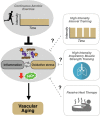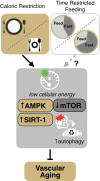Healthy lifestyle-based approaches for successful vascular aging
- PMID: 30212305
- PMCID: PMC6842891
- DOI: 10.1152/japplphysiol.00521.2018
Healthy lifestyle-based approaches for successful vascular aging
Abstract
This review summarizes a presentation given at the 2016 Gerontological Society of America Annual Meeting as part of the Vascular Aging Workshop. The development of age-related vascular dysfunction increases the risk of cardiovascular disease as well as other chronic age-associated disorders, including chronic kidney disease and Alzheimer's disease. Healthy lifestyle behaviors, most notably regular aerobic exercise and certain dietary patterns, are considered "first-line" strategies for the prevention and/or treatment of vascular dysfunction with aging. Despite the well-established benefits of these strategies, however, many older adults do not meet the recommended guidelines for exercise or consume a healthy diet. Therefore, it is important to establish alternative and/or complementary evidence-based approaches to prevent or reverse age-related vascular dysfunction. Time-efficient forms of exercise training, hormetic exposure to mild environmental stress, fasting "mimicking" dietary paradigms, and nutraceutical/pharmaceutical approaches to favorably modulate cellular and molecular pathways activated by exercise and healthy dietary patterns may hold promise as such alternative approaches. Determining the efficacy of these novel strategies is important to provide alternatives for adults with low adherence to conventional healthy lifestyle practices for healthy vascular aging.
Keywords: caloric restriction; energy sensing; inflammation; nitric oxide; oxidative stress.
Conflict of interest statement
No conflicts of interest, financial or otherwise, are declared by the authors.
Figures




References
-
- Centers for Disease Control and Prevention (CDC) Prevalence of self-reported physically active adults—United States, 2007. MMWR Morb Mortal Wkly Rep 57: 1297–1300, 2008. - PubMed
-
- Ahluwalia A, Gladwin M, Coleman GD, Hord N, Howard G, Kim-Shapiro DB, Lajous M, Larsen FJ, Lefer DJ, McClure LA, Nolan BT, Pluta R, Schechter A, Wang CY, Ward MH, Harman JL. Dietary nitrate and the epidemiology of cardiovascular disease: report from a National Heart, Lung, and Blood Institute workshop. J Am Heart Assoc 5: e003402, 2016. doi:10.1161/JAHA.116.003402. - DOI - PMC - PubMed
-
- Akazawa N, Choi Y, Miyaki A, Tanabe Y, Sugawara J, Ajisaka R, Maeda S. Effects of curcumin intake and aerobic exercise training on arterial compliance in postmenopausal women. Artery Res 7: 67–72, 2013. doi:10.1016/j.artres.2012.09.003. - DOI
-
- Benjamin EJ, Blaha MJ, Chiuve SE, Cushman M, Das SR, Deo R, de Ferranti SD, Floyd J, Fornage M, Gillespie C, Isasi CR, Jiménez MC, Jordan LC, Judd SE, Lackland D, Lichtman JH, Lisabeth L, Liu S, Longenecker CT, Mackey RH, Matsushita K, Mozaffarian D, Mussolino ME, Nasir K, Neumar RW, Palaniappan L, Pandey DK, Thiagarajan RR, Reeves MJ, Ritchey M, Rodriguez CJ, Roth GA, Rosamond WD, Sasson C, Towfighi A, Tsao CW, Turner MB, Virani SS, Voeks JH, Willey JZ, Wilkins JT, Wu JH, Alger HM, Wong SS, Muntner P; American Heart Association Statistics Committee and Stroke Statistics Subcommittee . Heart Disease and Stroke Statistics-2017 Update: A Report From the American Heart Association. Circulation 135: e146–e603, 2017. [Erratum in: Circulation 135: e646, 2017. doi:10.1161/CIR.0000000000000491. . Comment in: J Card Fail 23: 271, 2017. doi:10.1016/j.cardfail.2017.02.005. ] doi:10.1161/CIR.0000000000000485. - DOI - DOI - DOI - PMC - PubMed
Publication types
MeSH terms
Grants and funding
LinkOut - more resources
Full Text Sources
Other Literature Sources
Medical

